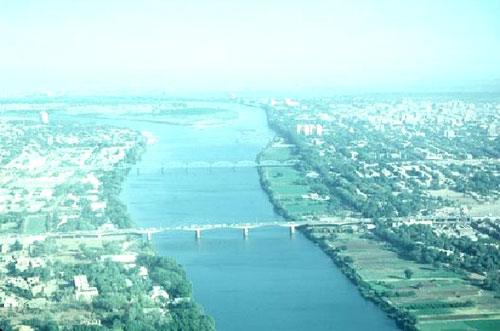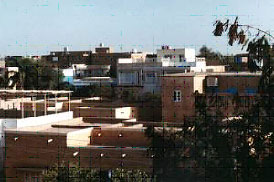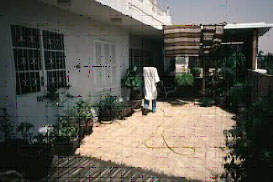Khartoum is the capital of Sudan, and one of three sister cities built at the convergence of the Blue and White Niles: Omdurman to the north-west across the White Nile, North Khartoum, and Khartoum itself on the southern bank of the Blue Nile.
The Blue Nile at Khartoum, flowing front to back, south to north. Khartoum is on the left; Khartoum North on the right.
It is an arid capital city with a population of 800,000. Khartoum has a relatively short history. It was first established as a military outpost in 1821, and is said to derive its name from the thin spit of land at the convergence of the rivers, which resembles an elephant's trunk (khurtum). Khartoum grew rapidly in prosperity during the boom years of the slave trade, between 1825 and 1880. In 1834 it became the capital of the Sudan, and many explorers from Europe used it as a base for their African expeditions.
Khartoum was sacked twice during the latter half of the 19th century -- once by the Muhammad Ahmed al-Mahdi the most influential political and religious personality in the history of the modern Sudan; and once by Lord Kitchener, who was appointed governor of the British Red Sea Territories. In 1898 he defeated the Sudanese forces of al-Mahdi in the Battle of Omdurman and then occupied the nearby city of Khartoum. In 1898, Kitchener began to rebuild the city, and designed the streets in the shape of the British flag, the Union Jack, which he hoped would make it easier to defend. On the opposite bank of the Nile, North Khartoum was developed as an industrial area at about the same time.
Today's Khartoum is a quiet city. It has peaceful, tree-lined streets, and in some ways still bears the unmistakable mark of an outpost of the British Empire. It has expanded to accommodate a rapidly-growing population.
The city has a National Museum with antiquities from around the country, an ethnological museum with tribal artifacts, a natural-history museum with local bird and wild-game display.
photo source: www.greatmirror.com/




